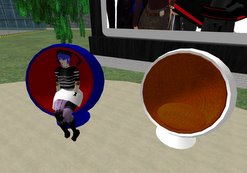Disquisitions on scholarly publishing: 1 (dull); Pictures of kittycats: 2 (cute).
Think is time to inject some Seriousness into blog again, so today's meditation is on changes in scholarly publishing. However, scholarly publishing not v. visually appealing, so will also include some pics of kittycats being cute as only kittycats can be.
Am venturing further into readings on autoethnography, and a week or two ago refound useful article called Analytical Ethnography (in folder helpfully labelled "articles"). Having read it and found it good, used, um, scarcely any information literacy skills at all to search on "analytic autoethongraphy" on Google Scholar and discovered article by another pair of autoethnographers in same journal issue as first article. This 2nd article was esentially doing a hatchet job of 1st article, but written in semi fictionalised narrative form i.e. was writing devasting critique in form of autoethnography.
This would have been neat ruse, were it not that 2nd article was:
a) in humourless, stilted prose and
b) framed with some exploitative stuff about watching live footage from a natural disaster and saying how dreadful it made the authors feel.
As side note, have been having serious concerns about whether autoethnography only counts as autoethnography if badly written. Hope not as in that case would immediately be disqualified from doing autoethnography because of sparkling style, ahem.
Anyway, 2nd article caused emotional reaction, as imagine authors wanted, but possibly not the emotions they might have hope to evoke when they put finger to keyboard. In fact can never remember being so incensed by article, and notes in margins had some rude words and lots of exclamation marks.
At this point decided to see whether were any other autoethnographic articles in same issue of journal: and lo, not only were there more articles, but one of then was by author of article A, responding to Article B's response to Article A.
This was all v. jolly and gave reading matter for weeks to come, but was useful evidence of way in which carefully crafted assemblage of interlocking articles (as in fact articles X, Y and Z were also responding to article A) is reduced to whatever you chance to hit on when you google.
Now with many journal issues this is not real problem, as issue basically consists of whatever stuff happens to have turned up at roughly the same time. However, journals do have themed issues and books also have chapters, and in now increasing chance that you stumble across one disconnected part of whole, possibly never realising that there was a whole it was part of.
This is not exactly new observation, but this particular instance made me think how in particular it becomes more difficult to see the links and tensions between different ideas, from people in the same field, particularly if you can't find the connections through citation searching. Finding connections and contradictions for yourself is enjoyable. However, don't always have time to browse at will, and also is particularly difficult if trying to get to grip with a new field.
Response to this has been to buy an actual book on autoethnography, rather than looking at snippets of books on google books, not that the latter is something I would normally do, obviously, absolutely not.
Meanwhile, the kittycats sleep.
Subscribe to:
Post Comments (Atom)
The blog of Sheila Yoshikawa on her adventures in Second Life. This may be very thrilling. Or possibly not.







No comments:
Post a Comment